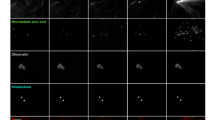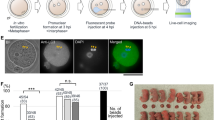Abstract
Extracts from Xenopus laevis eggs provide a powerful system for the study of cell division processes in vitro through biochemical reconstitution and manipulation, and microscopic analysis. We provide protocols for the preparation of metaphase-arrested extracts and in vitro assays to examine the following pathways of spindle assembly: 1) Sperm nuclei added to meiotic extracts, supporting the formation of half-spindles and bipolar spindle structures around unreplicated chromosomes; 2) sperm nuclei added to extracts that cycle through interphase and form spindles that are capable of undergoing anaphase and chromosome segregation; and 3) spindle formation around chromatin-coated beads. Finally, we describe methods to inhibit a specific protein by immunodepletion or addition of an inhibitor such as a dominant-negative construct. These techniques can be used to analyze the mitotic function of a given protein. It takes ∼1.5 h to prepare the extract, 1–3 h for spindle-assembly experiments and an additional 1–3 h if immunodepletion is performed.
This is a preview of subscription content, access via your institution
Access options
Subscribe to this journal
Receive 12 print issues and online access
$259.00 per year
only $21.58 per issue
Buy this article
- Purchase on Springer Link
- Instant access to full article PDF
Prices may be subject to local taxes which are calculated during checkout



Similar content being viewed by others
References
Murray, A.W. & Kirschner, M.W. Cyclin synthesis drives the early embryonic cell cycle. Nature 339, 275–280 (1989).
Verde, F., Labbe, J.C., Doree, M. & Karsenti, E. Regulation of microtubule dynamics by cdc2 protein kinase in cell-free extracts of Xenopus eggs. Nature 343, 233–238 (1990).
Belmont, L.D., Hyman, A.A., Sawin, K.E. & Mitchison, T.J. Real-time visualization of cell cycle-dependent changes in microtubule dynamics in cytoplasmic extracts. Cell 62, 579–589 (1990).
Hirano, T. & Mitchison, T.J. Cell cycle control of higher-order chromatin assembly around naked DNA in vitro. J. Cell Biol. 115, 1479–1489 (1991).
Lohka, M.J. & Masui, Y. Formation in vitro of sperm pronuclei and mitotic chromosomes induced by amphibian ooplasmic components. Science 220, 719–721 (1983).
Desai, A., Deacon, H.W., Walczak, C.E. & Mitchison, T.J. A method that allows the assembly of kinetochore components onto chromosomes condensed in clarified Xenopus egg extracts. Proc. Natl. Acad. Sci. USA 94, 12378–12383 (1997).
Sawin, K.E. & Mitchison, T.J. Mitotic spindle assembly by two different pathways in vitro. J. Cell Biol. 112, 925–940 (1991).
Lohka, M.J. & Maller, J.L. Induction of nuclear envelope breakdown, chromosome condensation, and spindle formation in cell-free extracts. J. Cell Biol. 101, 518–523 (1985).
Desai, A., Maddox, P.S., Mitchison, T.J. & Salmon, E.D. Anaphase A chromosome movement and poleward spindle microtubule flux occur at similar rates in Xenopus extract spindles. J. Cell Biol. 141, 703–713 (1998).
Murray, A.W., Desai, A.B. & Salmon, E.D. Real time observation of anaphase in vitro. Proc. Natl. Acad. Sci. USA 93, 12327–12332 (1996).
Shamu, C.E. & Murray, A.W. Sister chromatid separation in frog egg extracts requires DNA topoisomerase II activity during anaphase. J. Cell Biol. 117, 921–934 (1992).
Schmidt, A., Rauh, N.R., Nigg, E.A. & Mayer, T.U. Cytostatic factor: an activity that puts the cell cycle on hold. J. Cell Sci. 119, 1213–1218 (2006).
Heald, R. et al. Self-organization of microtubules into bipolar spindles around artificial chromosomes in Xenopus egg extracts. Nature 382, 420–425 (1996).
Budde, P.P. & Heald, R. Centrosomes and kinetochores, who needs 'Em? The role of noncentromeric chromatin in spindle assembly. Curr. Top. Dev. Biol. 56, 85–113 (2003).
Maiato, H., Rieder, C.L. & Khodjakov, A. Kinetochore-driven formation of kinetochore fibers contributes to spindle assembly during animal mitosis. J. Cell Biol. 167, 831–840 (2004).
Heald, R., Tournebize, R., Habermann, A., Karsenti, E. & Hyman, A. Spindle assembly in Xenopus egg extracts: respective roles of centrosomes and microtubule self-organization. J. Cell Biol. 138, 615–628 (1997).
Murray, A. in Methods in Cell Biology (eds. Kay, B.K. & Peng, H.B.) 581–605 (Academic Press, San Diego, 1991).
Vernos, I. et al. Xklp1, a chromosomal Xenopus kinesin-like protein essential for spindle organization and chromosome positioning. Cell 81, 117–127 (1995).
Wittmann, T. & Hyman, T. Recombinant p50/dynamitin as a tool to examine the role of dynactin in intracellular processes. Methods Cell Biol. 61, 137–143 (1999).
Wignall, S.M. et al. Identification of a novel protein regulating microtubule stability through a chemical approach. Chem. Biol. 11, 135–146 (2004).
Wu, M. & Gerhart, J. in Methods in Cell Biology (eds. Kay, B.K. & Peng, H.B.) 3–18 (Academic Press, San Diego, 1991).
Hyman, A. et al. in Methods in Enzymology (ed. Vallee, R.B.) 478–485 (Academic Press, San Diego, 1991).
Morin, N., Abrieu, A., Lorca, T., Martin, F. & Doree, M. The proteolysis-dependent metaphase to anaphase transition: calcium/calmodulin-dependent protein kinase II mediates onset of anaphase in extracts prepared from unfertilized Xenopus eggs. EMBO J. 13, 4343–4352 (1994).
Gaglio, T. et al. Opposing motor activities are required for the organization of the mammalian mitotic spindle pole. J. Cell Biol. 135, 399–414 (1996).
Merdes, A., Ramyar, K., Vechio, J.D. & Cleveland, D.W. A complex of NuMA and cytoplasmic dynein is essential for mitotic spindle assembly. Cell 87, 447–458 (1996).
Sawin, K.E., LeGuellec, K., Philippe, M. & Mitchison, T.J. Mitotic spindle organization by a plus-end-directed microtubule motor. Nature 359, 540–543 (1992).
Walczak, C.E., Mitchison, T.J. & Desai, A. XKCM1: a Xenopus kinesin-related protein that regulates microtubule dynamics during mitotic spindle assembly. Cell 84, 37–47 (1996).
Author information
Authors and Affiliations
Corresponding author
Ethics declarations
Competing interests
The authors declare no competing financial interests.
Rights and permissions
About this article
Cite this article
Hannak, E., Heald, R. Investigating mitotic spindle assembly and function in vitro using Xenopus laevis egg extracts. Nat Protoc 1, 2305–2314 (2006). https://doi.org/10.1038/nprot.2006.396
Published:
Issue Date:
DOI: https://doi.org/10.1038/nprot.2006.396
This article is cited by
-
Acentrosomal spindles assemble from branching microtubule nucleation near chromosomes in Xenopus laevis egg extract
Nature Communications (2023)
-
Macromolecular condensation buffers intracellular water potential
Nature (2023)
-
A gelation transition enables the self-organization of bipolar metaphase spindles
Nature Physics (2022)
-
A hydrodynamic instability drives protein droplet formation on microtubules to nucleate branches
Nature Physics (2021)
-
Phase separation of TPX2 enhances and spatially coordinates microtubule nucleation
Nature Communications (2020)
Comments
By submitting a comment you agree to abide by our Terms and Community Guidelines. If you find something abusive or that does not comply with our terms or guidelines please flag it as inappropriate.



